Thinking about getting a pet hamster but wondering, how much is a hamster? These small, adorable pets may seem like a budget-friendly choice, but the costs can add up quickly if you’re not prepared. From the initial price of the hamster to ongoing expenses like food, bedding, and vet care, it’s essential to understand the true cost of owning one.
In this guide, we’ll break down the price of hamsters, the cost of essential supplies, and monthly expenses. Plus, we’ll share money-saving tips to help you care for your new furry friend without overspending. Whether you’re considering a Syrian, Dwarf, or Roborovski hamster, this post will help you make an informed decision before bringing one home!
How Much Does a Hamster Cost?
Pet Store Hamster Cost
Buying a hamster from a pet store like PetSmart, Petco, or local pet shops typically costs between $10 and $40, depending on the breed and location. Large chain stores often price hamsters lower than small, independent pet shops because they sell a higher volume of animals. Some stores may also include a small starter kit with a purchase, but most of the essential supplies must be bought separately.
Local pet stores might charge more, but they sometimes offer healthier hamsters because they source them from responsible breeders rather than mass suppliers. Before purchasing, always check the hamster’s health, activity level, and fur condition to ensure you’re getting a healthy pet.
Cheapest Hamster Breeds
Not all hamsters cost the same, and breed plays a significant role in pricing. Here’s a breakdown of the most common breeds and their average prices:
- Syrian Hamster ($10–$25): This is the most popular breed and usually the easiest to find. Since Syrians are larger, they need bigger cages and accessories, which increases overall costs.
- Dwarf Hamsters ($10–$30): This category includes Campbell’s, Winter White, and Chinese hamsters. These tiny pets are more active and social but require smaller accessories, which can sometimes make them more affordable.
- Roborovski Hamster ($15–$40): These are the smallest and fastest hamsters, making them a fun but challenging pet. Their higher price comes from their rarity and special care needs.
Adopting a hamster from a rescue or shelter can sometimes reduce costs, with adoption fees ranging from $5 to $15. Some shelters also provide initial supplies or vet checkups, making it a budget-friendly option.
Factors Affecting Hamster Price
Several factors determine how much you’ll pay for a hamster:
- Breed and Rarity: Some breeds, like Roborovskis, cost more because they are less common. Rare color variations, such as albino or long-haired Syrian hamsters, can also raise the price.
- Pet Store vs. Breeder: Hamsters from reputable breeders usually cost more than those from pet stores. However, breeders often provide healthier, well-socialized hamsters with detailed care information.
- Location and Availability: Prices can vary based on where you live. In areas with fewer pet stores or breeders, hamsters may be more expensive due to limited supply.
- Age and Health Condition: Younger hamsters generally cost more than older ones because they have a longer lifespan ahead. A hamster with special medical needs might be cheaper but could lead to higher vet expenses.
By understanding these factors, you can make an informed decision about where and how to buy your new furry friend while staying within your budget.
Initial Costs of Owning a Hamster
Hamster Cage Cost
Choosing the right cage for your hamster plays a crucial role in their health and happiness. Hamster cages range in price from $30 to $150, depending on size, material, and design.
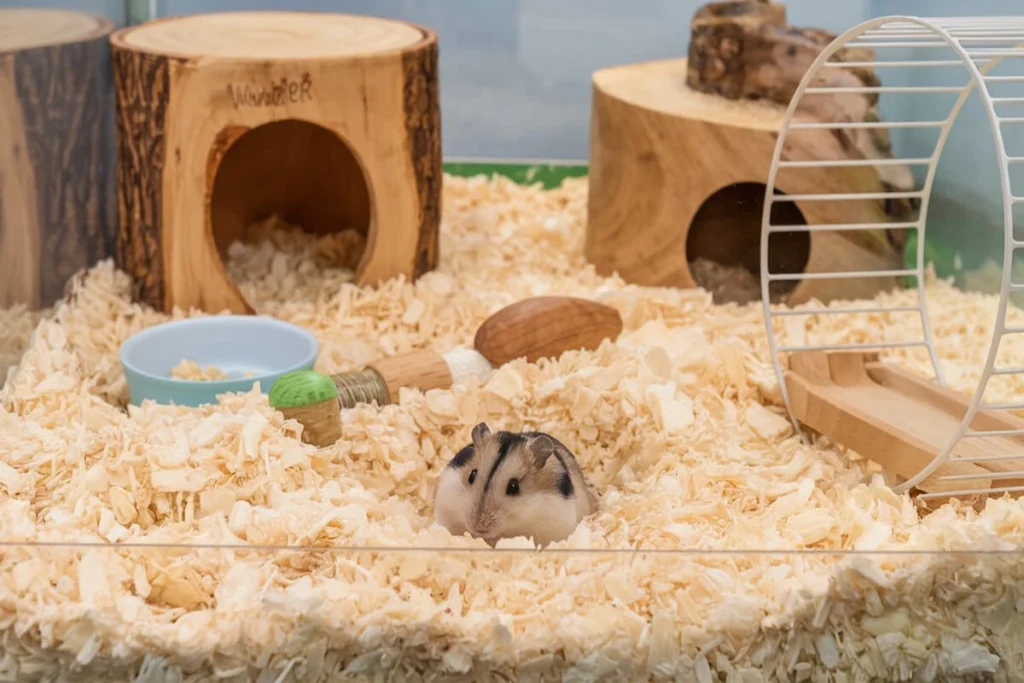
- Basic Wire Cages ($30–$60): These cages provide good ventilation and easy cleaning, but the bar spacing must be small enough to prevent escapes, especially for Dwarf hamsters.
- Plastic Modular Cages ($50–$100): Brands like CritterTrail and Habitrail offer colorful, interconnected cages with tunnels and hideouts. While they look fun, they often lack ventilation and space, making them less ideal for long-term use.
- Glass Tanks ($50–$150): A 20-gallon or larger glass tank provides excellent space and prevents escapes. However, you’ll need a secure mesh lid to allow proper airflow.
- DIY Bin Cages ($20–$50): Many hamster owners choose large plastic storage bins as a budget-friendly alternative. By cutting out sections for ventilation and adding mesh, you can create a spacious and affordable habitat.
The ideal cage should provide at least 450 square inches of unbroken floor space, though bigger is always better. Small cages might seem cheaper upfront, but upgrading later can cost more in the long run.
Bedding and Nesting Materials
Hamsters love to burrow, so choosing the right bedding is essential for their comfort. Bedding costs $10 to $30 per month, depending on material and quantity.
- Paper-Based Bedding ($10–$25): Brands like Carefresh and Kaytee Clean & Cozy offer soft, absorbent, and dust-free bedding that’s safe for hamsters.
- Aspen Wood Shavings ($10–$20): Aspen is the only safe wood-based bedding. It’s a cost-effective option but doesn’t control odor as well as paper bedding.
- Fleece Liners ($15–$30, reusable): Some owners prefer fleece liners as an eco-friendly option. While they reduce waste, they require frequent washing to maintain hygiene.
Avoid cedar and pine shavings, as they release harmful oils that can cause respiratory issues. Nesting materials like unscented toilet paper or paper towel strips provide a soft, safe place for hamsters to sleep without added cost.
Essential Accessories
A well-equipped hamster habitat includes more than just a cage and bedding. Essential accessories typically cost $30 to $100, depending on quality and brand.
- Exercise Wheel ($10–$30): Hamsters need a properly sized wheel to stay active. Syrian hamsters require at least a 10–12 inch wheel, while Dwarf hamsters can use an 8-inch wheel. Silent wheels, like the Silent Runner or Niteangel, reduce noise at night.
- Food Bowl & Water Bottle ($5–$20): Choose a ceramic food dish (to prevent tipping) and a leak-proof water bottle or water bowl for hydration.
- Hideouts and Tunnels ($10–$30): Hamsters need at least one wooden or plastic hideout for security. Adding tunnels and bridges enriches their environment and mimics natural burrows.
- Chew Toys ($5–$15): Since hamster teeth grow continuously, they need wood chews, mineral chews, or safe cardboard items to prevent overgrowth.
Investing in high-quality accessories ensures your hamster stays happy and healthy while avoiding unnecessary replacement costs.
Monthly Hamster Expenses
Hamster Food Price
Feeding a hamster doesn’t cost much compared to larger pets, but choosing high-quality food ensures they stay healthy. The monthly cost of hamster food ranges from $5 to $20, depending on the type and brand.
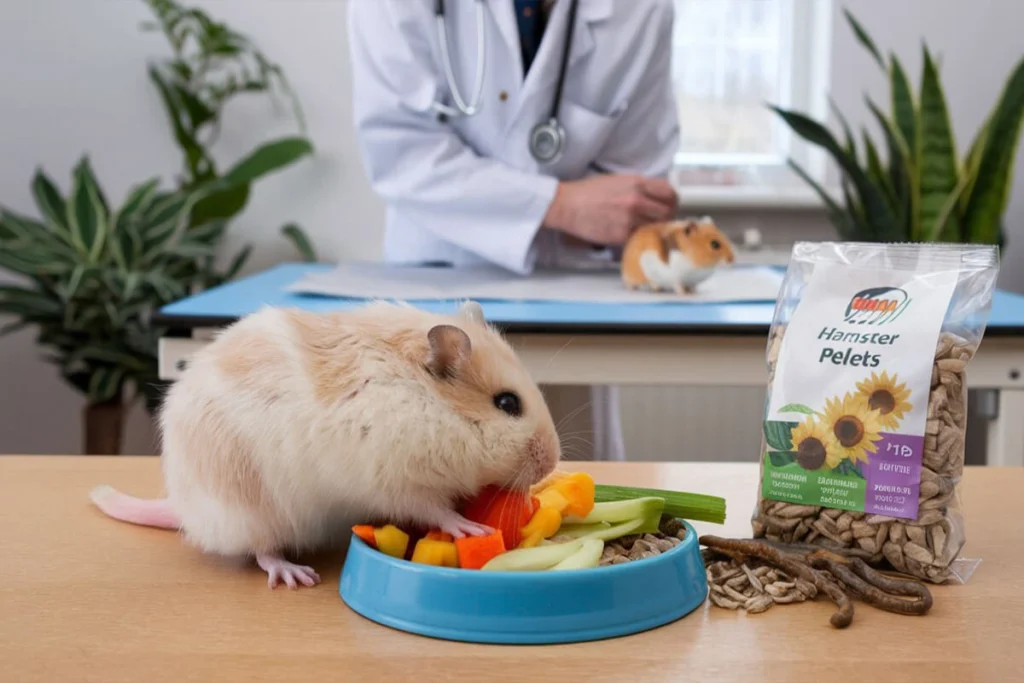
- Pellets and Seed Mixes ($5–$15 per bag): A good-quality hamster diet includes a balanced seed mix or fortified pellets. Popular brands like Higgins Sunburst, Oxbow, and Mazuri provide essential nutrients. Syrians and Dwarf hamsters have different dietary needs, so choosing a species-appropriate mix is crucial.
- Fresh Fruits and Vegetables ($5–$10 per month): Hamsters enjoy occasional treats like carrots, cucumbers, apples, and broccoli. Always feed these in moderation and avoid toxic foods like onions, garlic, and citrus fruits.
- Healthy Treats and Protein Sources ($3–$10 per month): Hamsters need protein from sources like mealworms, boiled eggs, or plain chicken. You can also buy hamster-safe treats like dried fruits, nuts, and yogurt drops, but avoid sugary or artificially flavored snacks.
Buying hamster food in bulk helps save money in the long run, but always check expiration dates to ensure freshness.
Bedding Replacement Costs
Hamsters need clean bedding to stay comfortable and odor-free. Depending on the type of bedding and cage size, you’ll spend $10 to $30 per month replacing and maintaining it.
- Spot Cleaning (Daily): Remove soiled bedding and leftover food daily to keep the cage fresh.
- Partial Bedding Changes (Weekly): Replace around one-third of the bedding every week to prevent odors and bacteria buildup.
- Full Bedding Replacement (Every 3–4 Weeks): Change all bedding monthly and thoroughly clean the cage with pet-safe disinfectants.
Buying bedding in larger quantities reduces overall costs. Paper-based bedding like Kaytee Clean & Cozy and Carefresh absorbs odors well and lasts longer. Avoid scented bedding, as artificial fragrances can irritate a hamster’s sensitive respiratory system.
Vet Visits and Healthcare Expenses
Many first-time hamster owners overlook vet costs, but medical expenses can add up over time. Unlike cats or dogs, hamsters don’t need vaccinations, but they still require occasional checkups and emergency care.
- Routine Vet Checkups ($30–$60 per visit): Taking your hamster to a small animal or exotic pet vet once a year helps detect early signs of illness. Some vets offer wellness exams that include weight checks, dental inspections, and overall health assessments.
- Emergency Vet Costs ($50–$200+): Hamsters hide illnesses well, so by the time symptoms appear, they might need urgent care. Common health issues include wet tail (diarrhea), respiratory infections, and overgrown teeth.
- Medications and Treatments ($10–$50 per prescription): If a hamster develops an infection or injury, they may need antibiotics, pain relief, or surgery. Since small pets require specialized care, finding an exotic vet in your area ensures you have access to proper treatment.
Setting aside an emergency fund of $100 to $200 for unexpected vet bills ensures you can provide immediate care if your hamster gets sick or injured. Regular monitoring, a clean environment, and a balanced diet help prevent many common health issues.
Hidden Costs of Hamster Ownership
Upgrading Cage Size and Accessories
Many new hamster owners start with small cages, only to realize later that their pet needs more space. A hamster requires at least 450 square inches of floor space, but larger enclosures lead to happier and healthier pets. Upgrading a cage can cost anywhere from $50 to $200, depending on the type and quality of materials.
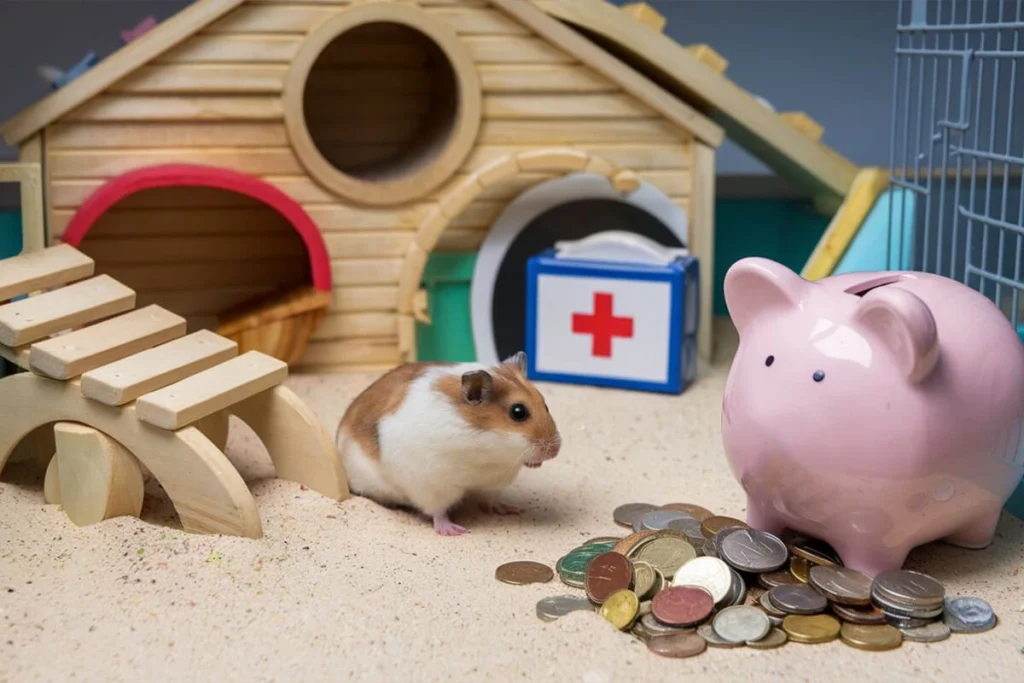
- Why Upgrade? A cramped cage leads to stress, excessive chewing on bars, and even health issues like obesity or boredom-related behaviors. If a hamster constantly tries to escape or seems restless, upgrading the cage provides the necessary space for natural activities like burrowing and running.
- Best Upgrade Options:
- Larger wire cages ($80–$150): Models like the Prevue 528 or Niteangel Vista provide ample space and good ventilation.
- Glass tanks ($100–$200): A 40-gallon breeder tank or larger offers excellent visibility and keeps bedding from spilling out.
- DIY bin cages ($30–$60): A 105-quart or larger plastic storage bin with mesh ventilation makes an affordable and spacious home.
- Additional Accessories ($20–$50): Upgrading often means adding larger wheels, hides, and tunnels to fit the expanded space. A hamster-friendly layout includes a deep bedding area for burrowing, climbing structures, and plenty of enrichment.
Investing in a larger cage early on prevents unnecessary spending on temporary solutions, ensuring your hamster has enough space from the start.
Unexpected Veterinarian Costs
Hamsters are small, but their medical bills can be surprisingly expensive. Emergency vet visits can range from $50 to $300, depending on the condition and treatment required. Owners should always prepare for unexpected health problems, as hamsters are prone to injuries, infections, and dental issues.
- Common Health Emergencies:
- Wet Tail ($50–$200): This severe bacterial infection causes diarrhea, dehydration, and lethargy. Immediate vet care is necessary.
- Abscesses or Tumors ($75–$250): If a hamster develops lumps or infections, a vet might need to drain an abscess or remove a tumor surgically.
- Respiratory Infections ($50–$150): Sneezing, wheezing, or labored breathing could indicate a lung infection that requires antibiotics.
- Teeth and Nail Overgrowth ($20–$80): If a hamster’s teeth or nails become too long, they may need trimming by a vet.
- How to Reduce Vet Expenses:
- Preventive Care: Keep the cage clean, provide a balanced diet, and monitor behavior changes to catch health issues early.
- Find an Exotic Vet in Advance: Not all veterinarians treat small animals, so researching local exotic pet specialists before an emergency saves time.
- Set Up an Emergency Fund: Putting aside $100 to $200 ensures financial preparedness for sudden medical costs.
Though hamsters are relatively low-maintenance pets, vet expenses can arise unexpectedly. Staying prepared helps avoid stress when emergencies happen.
Toys and Enrichment for a Happy Hamster
Hamsters need mental and physical stimulation to stay happy. Without enough activities, they might develop boredom-related behaviors like bar chewing or excessive digging. Investing in toys and enrichment helps keep them engaged and active.
- Essential Enrichment Items ($10–$50):
- Exercise Wheel ($10–$30): A properly sized wheel allows hamsters to run and burn energy. Syrian hamsters need at least a 10–12-inch wheel, while Dwarf hamsters can use an 8-inch wheel.
- Tunnels and Hideouts ($10–$25): Adding wooden logs, PVC tubes, or ceramic hides creates a fun and safe environment for exploring.
- Sand Bath ($10–$20): Hamsters love rolling in chinchilla sand to keep their fur clean and oil-free. Avoid dust-based products, as they can cause respiratory issues.
- DIY Enrichment Options ($0–$10):
- Cardboard Tubes: Empty toilet paper or paper towel rolls provide tunnels and chewable fun.
- Egg Cartons and Tissue Boxes: Cut holes into these household items to create inexpensive hideouts.
- Homemade Digging Box: Fill a small container with shredded paper or safe bedding for burrowing fun.
Rotating toys every 1–2 weeks prevents boredom and keeps a hamster’s environment stimulating. Providing different textures, materials, and climbing opportunities mimics their natural habitat, leading to a healthier and more content pet.
Best Tips for Saving Money on Hamster Care
Choosing the Right Breed for Affordability
Hamster prices vary based on breed, size, and availability. If you want a budget-friendly hamster, choosing the right breed can help keep both the initial and long-term costs low.
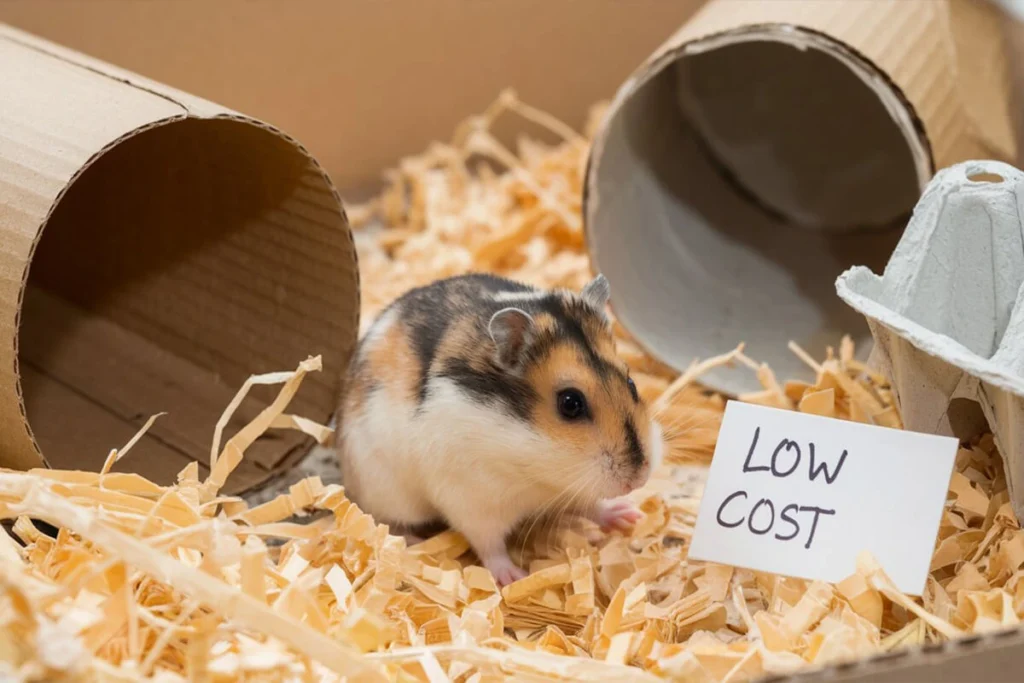
- Syrian Hamsters ($10–$25): These are the most common and affordable pet hamsters. Since they are larger, they require bigger cages and accessories, which can increase overall costs. However, their solitary nature means you only need to house one hamster, reducing the need for extra cages or supplies.
- Dwarf Hamsters ($10–$30): Breeds like Campbell’s, Winter White, and Chinese hamsters are small, social, and often sold in pairs, which can double costs. They require less space than Syrians but may need larger groups if housed together, leading to higher food and bedding expenses.
- Roborovski Hamsters ($15–$40): These tiny, fast-moving hamsters are slightly more expensive due to their rarity. Their care needs include extra enrichment and exercise space, which can increase overall costs.
For the most affordable option, a single Syrian hamster is the best choice, as it avoids the need for additional cages and food for multiple pets. Adopting a hamster from a rescue or shelter can also save money, with adoption fees as low as $5–$15, sometimes including a starter kit or health checkup.
Finding Deals on Cages and Accessories
Hamster cages and accessories can get expensive, but with the right approach, you can find budget-friendly options.
- Shop During Sales and Clearance Events: Pet stores like PetSmart, Petco, and Chewy often run sales on small pet supplies. Holiday discounts, Black Friday deals, and clearance sections offer big savings on cages, wheels, and bedding.
- Buy Secondhand or Pre-Owned Supplies: Websites like Facebook Marketplace, Craigslist, and eBay often have used hamster cages and accessories at half the retail price. Ensure the items are clean, safe, and escape-proof before using them.
- Compare Prices Online: Some online retailers offer better deals than in-store purchases. Websites like Amazon and Chewy frequently have lower prices on bedding, food, and toys. Using price-tracking tools helps find the best deals.
- Use DIY or Budget-Friendly Alternatives: Instead of buying expensive modular cages, you can make a DIY bin cage for as little as $20–$50 using a large plastic storage bin with mesh ventilation.
By planning purchases strategically and looking for discounts, you can significantly reduce the cost of setting up a hamster habitat.
DIY Hamster Toys and Bedding Alternatives
Making homemade hamster toys and bedding saves money while keeping your pet entertained. Many household items can be repurposed into fun and engaging accessories.
- DIY Hamster Toys ($0–$10):
- Cardboard Tubes: Empty toilet paper and paper towel rolls make excellent tunnels and chew toys.
- Egg Cartons: Cut small openings in an egg carton to create a fun hideout for your hamster.
- Popsicle Stick Bridges: Glue together non-toxic popsicle sticks to make ladders and climbing structures.
- Shredded Paper Digging Box: Fill a small plastic container with shredded paper for burrowing fun.
- DIY Bedding Alternatives ($0–$10 per month):
- Unscented Toilet Paper or Paper Towels: These provide a soft, safe, and cost-effective alternative to store-bought nesting material.
- Hand-Shredded Newspaper (Ink-Free): If you have non-toxic, ink-free paper, you can shred it into bedding. Avoid glossy magazine paper or anything with colored ink.
- Old Fabric Scraps (Fleece Only): Cut fleece fabric into small pieces for a reusable and washable bedding option.
These DIY options keep your hamster’s environment engaging while cutting down on unnecessary expenses. With a little creativity, you can provide a comfortable and fun home for your pet without spending a fortune.
Conclusion
Bringing a hamster into your home can be an affordable and rewarding experience, but planning ahead helps avoid unexpected expenses. How much is a hamster? The cost varies based on breed, cage size, food, and ongoing care, but with smart budgeting, owning a hamster remains one of the most cost-effective pet options.
By choosing a budget-friendly breed, finding deals on cages and accessories, and using DIY bedding and toys, you can significantly reduce the upfront and monthly costs. Regular care, a proper diet, and a well-maintained habitat ensure your hamster stays healthy and happy, preventing costly vet visits in the long run.
Owning a hamster requires commitment, but with the right preparation, you can provide a loving and enriching environment without breaking the bank. Whether you’re a first-time owner or looking to expand your small pet family, understanding the full cost of hamster ownership allows you to make an informed decision and enjoy the experience without financial stress.
Choose The Best Name For your Lovely Hamster from our Top 100 Names HERE!
Read More about Furry Pets From HERE!
Discover Some Good stuff for your Pet On Pet MD Official
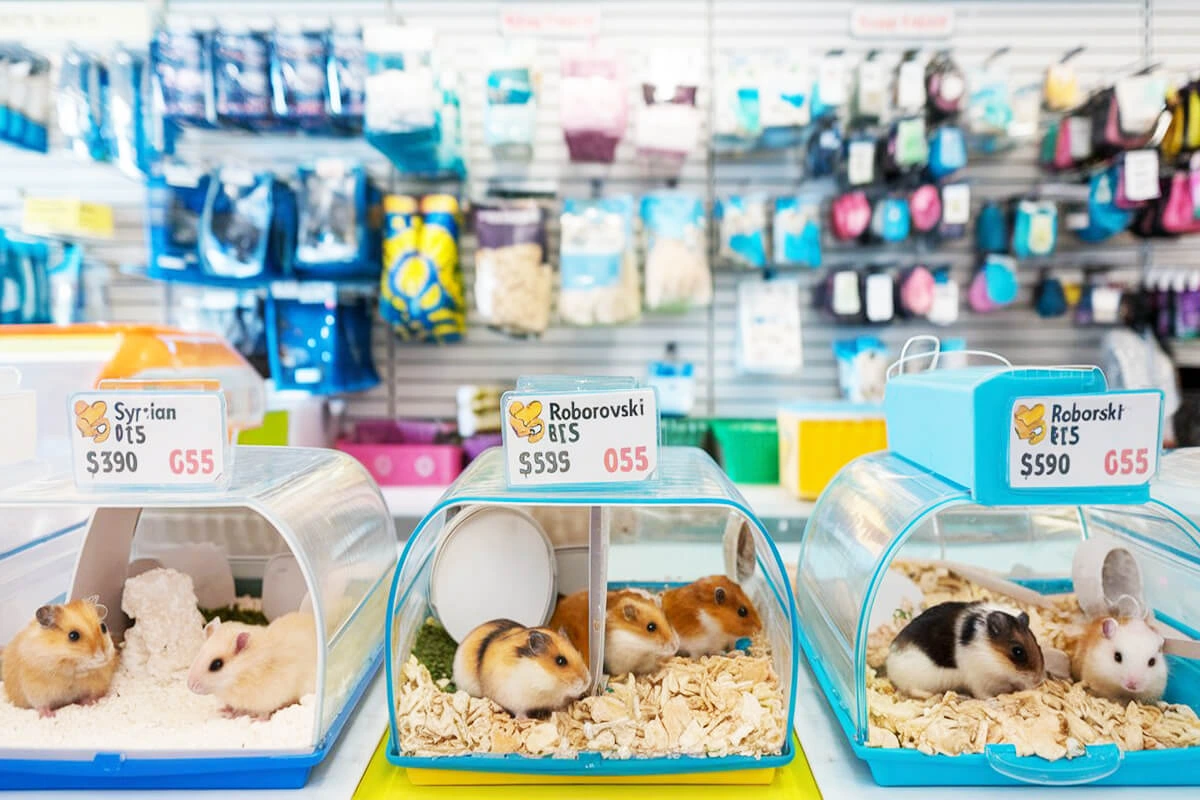
1 thought on “How Much Is a Hamster? Best Tips Before Getting one”
Comments are closed.